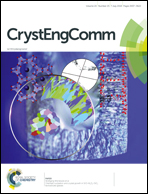Origin of gypsum growth habit difference as revealed by molecular conformations of surface-bound citrate and tartrate†
Abstract
The introduction of various organic acids during gypsum (CaSO4·2H2O) crystallization could change the crystallization behavior of gypsum leading to different macroscopic properties. Understanding the origin of organic acids in gypsum crystallization at an atomic level is the key step for us to rationalize the design of gypsum-related products. Here, citric acid (CA) and L-(+)-tartaric acid (LTA) were selected as two model compounds to investigate such organic–inorganic interactions. CA has the stronger retarding effect of gypsum precipitation as compared with LTA. The introduction of CA in aqueous solution results in the formation of a final plate-like gypsum crystal with a smaller specific surface area. However, the presence of LTA does not change the gypsum crystal morphology and the specific surface area remains almost the same as that of pure gypsum. AFM was firstly used to characterize the surface roughness of the gypsum (010) plane, and it was found that only a monolayer organic–inorganic structure is formed on top of the gypsum (010) plane for both LTA and CA. Afterwards, synchrotron μ-FTIR was utilized to obtain the atomic structure information, and the results further confirm that a mono-tartrate structure is formed. Finally, advanced metadynamics simulation (MD) was employed to obtain detailed organic–inorganic structure information and the free energy landscape. The simulation results show that CA has a stronger affinity as compared with LTA. CA and LTA were found to prefer a stand up conformation on top of the gypsum (010) plane. The combination of numerous characterization techniques with MD simulations, for the first time, clarifies the organic–inorganic interfacial structure in the gypsum system.



 Please wait while we load your content...
Please wait while we load your content...